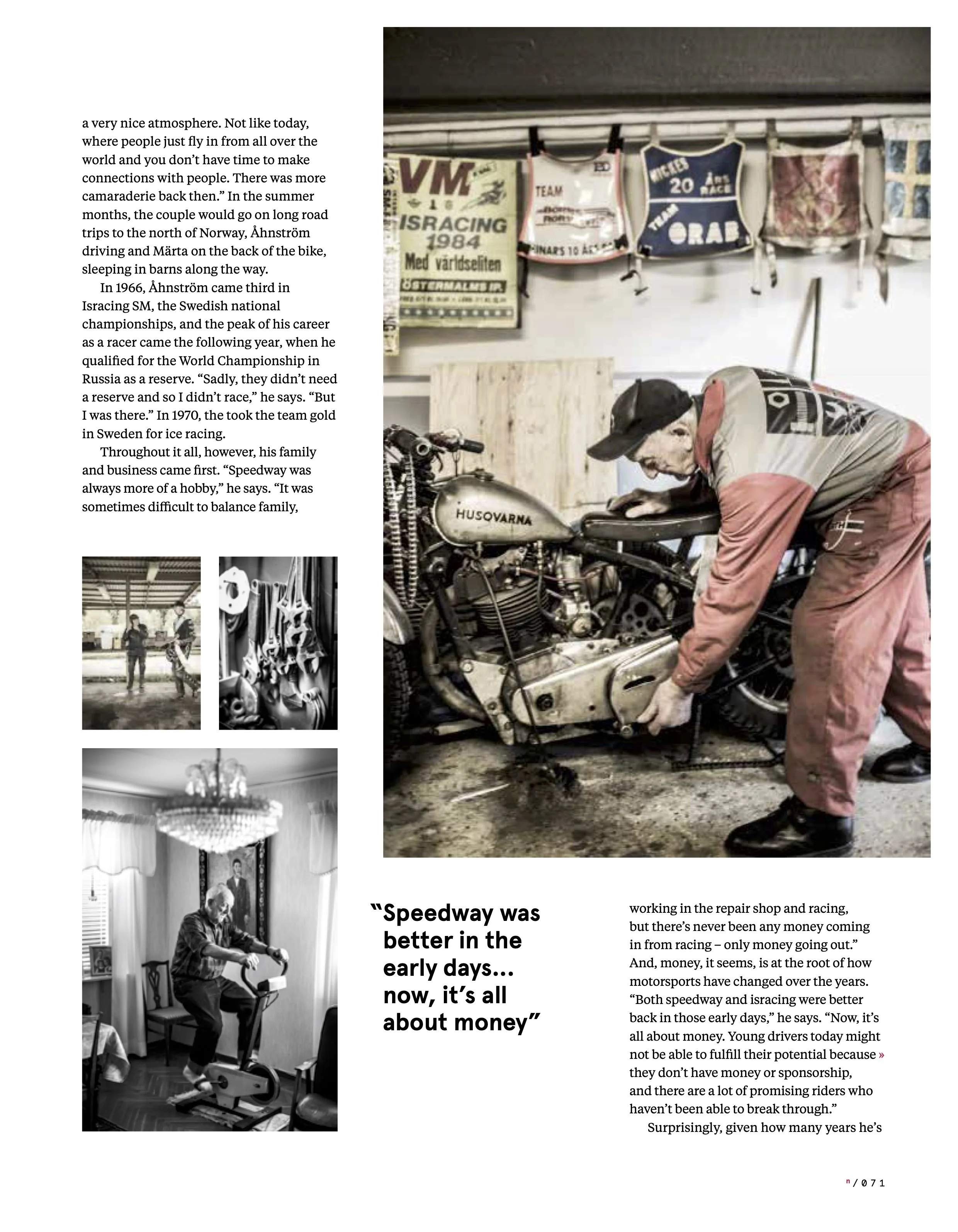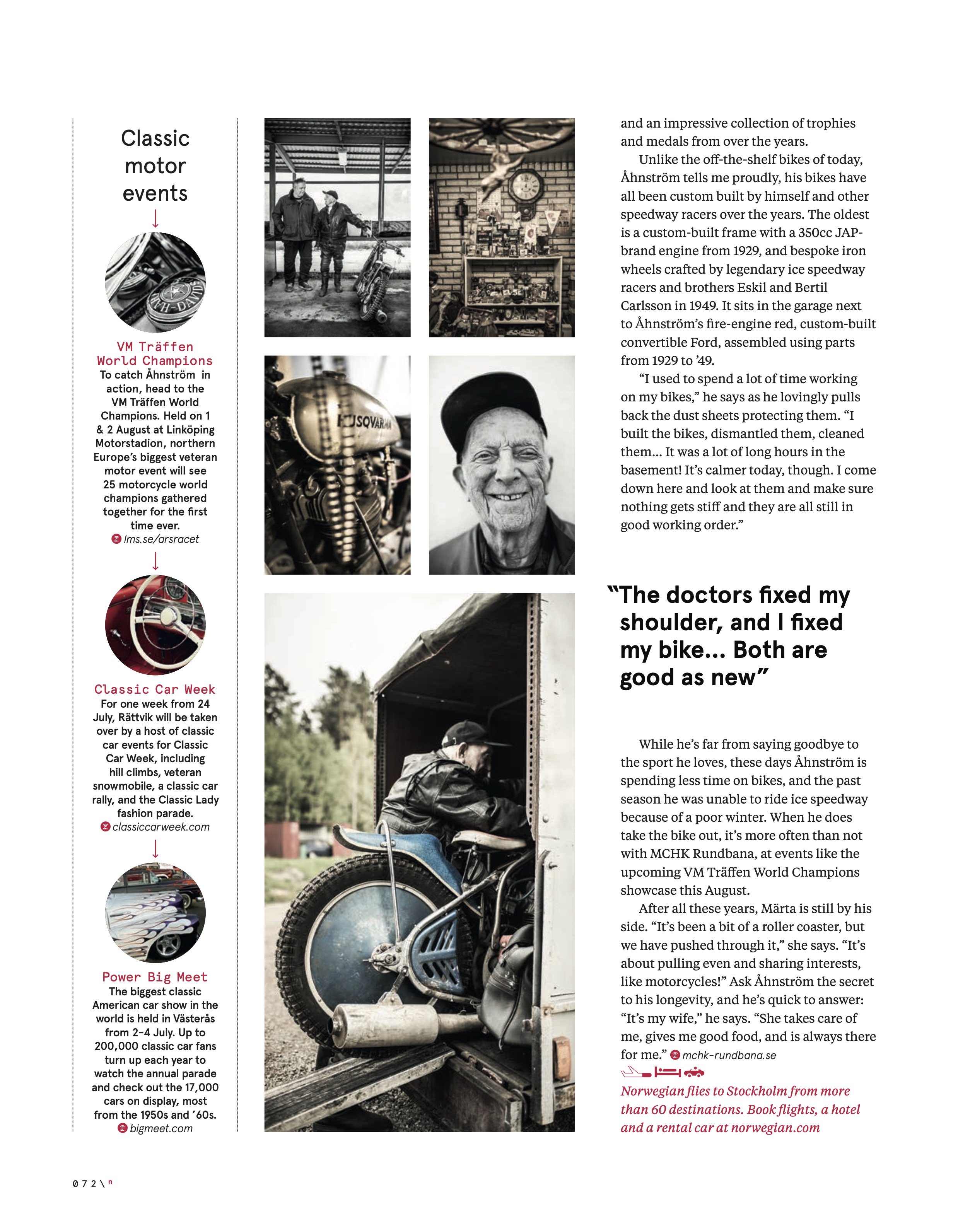N by Norwegian
Norwegian Air inflight magazine | July 2015
Olle Åhnström
Ninety-six-year-old Olle Åhnström has been riding speedway for over 60 years, and he’s showing no sign of hanging up his leathers.






I’m taking fika (Swedish afternoon tea) with 96-year-old Olle Åhnström and Märta, his wife of 73 years. We’re gathered in the cosy living room of the couple’s home in Huddinge, about 40 minutes outside Stockholm’s centre, eating three types of cake, freshly baked by Märta, and drinking from a seemingly endless pot of coffee.
Åhnström himself built the brick house in 1943, just after he and Märta married, and a lifetime of memories are collected here: photographs of the couple’s children, grandchildren, great-grandchildren and even a great-great-grandchild adorn the walls in every room; and every surface is covered by an eclectic selection of trinkets, including an ornate balalaika hanging on the living room wall. The balalaika, Åhnström explains, is a souvenir from the time he qualified as a reserve for the 1967 Ice Speedway World Championships in Russia. The lively nonagenarian, you see, is the most senior speedway rider in Sweden, and maybe even the world, today.
This is not a tag to be taken lightly. Speedway sees up to six motorbike riders compete over four laps of a circuit, with one gear, no brakes and travelling at speeds of up to 130kph. Ice speedway – a form of the sport that was born on Sweden’s frozen lakes in the 1920s and ’30s, and takes place on ice tracks using specially designed bikes with spiked wheels – is even more dangerous. Like dirt bikes, ice bikes have no brakes, and the spiked wheels create so much traction that a two-speed gearbox is a necessity and riders have to lean into extreme angles as they round corners. Åhnström has spent more than 60 years on bikes, and still rides both variations.
“Before I race, I have some nerves,” he says. “As soon as I get away though, it’s wonderful. I love the rushing air and the freedom of being on a motorcycle. You experience the world in a different way.”
As we drink coffee and eat cake, the unlikely rider talks about his seven decades racing. The first thing he does is hand me the jubilee calendar for Åtvidaberg, a Swedish municipality in Östergötland. The first month is illustrated by a shot of a 94-year-old Åhnström taken in 2013. It shows him sitting atop an old motorbike that looks like a prop from the set of Mad Max – a robust steel frame, with dual gearbox, and steel wheels adorned with 110 razor-sharp 28mm steel spikes at the front, and over 200 at the rear. Travelling at around 100kph, he’s leaning so far into the curve that the handlebar almost grazes the ice-covered track. On the straights, he tells me, he reaches speeds of over 130kph.
The picture was taken at a meeting of MCHK Rundbana, a veteran motorsports club in which all the members ride vintage bikes and race classic speedway, long track, ice racing and hill climbs. Most of the riders – like Åhnström – are all well past the age of retirement, but none of them are showing any signs of slowing down. If anything, the 250 members are testing the limits of how fast they can still go, meeting up regularly to race and partake in public showcases. The next meet, VM Träffen World Champions, on 1 & 2 August at Linköping Motorstadion, is the biggest yet, with 25 world champion veteran speedway racers set to race alongside other members, including Åhnström.
Born in 1919, Åhnström was a mechanic running his own repair shop when he met Märta at a summer dance in 1939 (he would run the repair shop until his retirement in 1986). They married in 1942, but it wasn’t until 1948, when Åhnström was 29, that he started riding speedway for the Tigrarna (Tigers) in the Swedish dirt-track league.
From the beginning, Märta has always been along for the ride, coaching, attending meets, and sharing his passion for bikes. “It’s important to share and support each other in marriage,” says Åhnström. “Märta has always pushed me and used to tell me that I would have to drive faster if I wanted to win anything.”
Åhnström bought his first bike in 1947, just after the war. “I’d always been interested in bikes, but this was the first opportunity I had to play with one,” he says. “I bought an old motorbike with Åke Dreifalt, a school friend who lived just up the road from here. It wasn’t a racing bike, just a normal bike with a 350cc engine, but we started using it to race hill climbs.”
In the early 1950s, there were close to 130 races across Sweden, and it was here that Åhnström began to race. “It was easy to organise competitions back then,” he says. “You would just call around the various organisers and ask if you could take part in the race meet, then you turned up and raced. These days, there are too many rules and regulations.”
It was also during this period that an ice speedway league was introduced – the equivalent to the dirt-track speedway league. In 1948 – a year after Åhnström got his first bike – ice speedway reached the height of its popularity, with a record 16,541 spectators turning out for an elite race at Stockholm Stadium on 10 February. In 1949, the Ice Speedway series premiered, and Thord Larsson, the Swedish champion known as the Ice King, remained unbeaten until 1969. Top riders like Larsson were idolised, and the new Swedish sport – known as isracing – was cemented as a part of popular culture in Sweden.
Before long, Åhnström and Dreifalt bought ice speedway bikes and began to learn how to race on the frozen lake track of Stockholm-based rider, Charles Aronsson. “Charles would put pine branches around the track so you could see where it was,” says Åhnström. “When I started learning, he put a branch in the corner of the track and told me I would know how to drive ice speedway when I could lean the bike over far enough to pick up the branch as I drove around the corner. It took me a couple of Sundays to learn.”
In his first race, Dreifalt fell and was run over by another rider’s bike, the hundreds of steel spikes puncturing his leg. “They almost had to amputate it,” says Åhnström. “And that, was the end of his racing career.” Åhnström’s career, however, was just beginning.
By the 1960s, Åhnström, was attending meets twice a week with Märta, often sharing the long drives with other racers. “We would get a group of friends together, throw everything on the back of a truck, and make a shelter with some hay. It was a very nice atmosphere. Not like today, where people just fly in from all over the world and you don’t have time to make connections with people. There was more camaraderie back then.” In the summer months, the couple would go on long road trips to the north of Norway, Åhnström driving and Märta on the back of the bike, sleeping in barns along the way.
In 1966, Åhnström came third in Isracing SM, the Swedish national championships, and the peak of his career as a racer came the following year, when he qualified for the World Championship in Russia as a reserve. “Sadly, they didn’t need a reserve and so I didn’t race,” he says. “But I was there.” In 1970, he took the team gold in Sweden for ice racing.
Surprisingly, given how many years he’s spent riding, Åhnström has never seriously injured himself in ice speedway – “Just a few bumps,” he says. On the speedway, however, it’s a different story. “In the ’50s, there was an accident where four riders crashed into each other coming into the first corner. I ripped the muscles in my shoulder, and doctors had to take » a piece of the muscle from my leg to repair my shoulder. That first corner is the most dangerous in both sports, as everyone comes into it together.”
Then, just 10 years ago, Åhnström was en route to a speedway meet when he was hit by a car, again injuring his shoulder. “The doctors fixed my shoulder, and I fixed my bike,” he says. “Both are good as new.” Despite the spills, however, Märta has never been too worried. “It’s all just a part of the game,” she says.
And, a game, says Åhnström, is all it really is. “Speedway was always more of a hobby,” he says. “It was sometimes difficult to balance family, working in the repair shop and racing, but there’s never been any money coming in from racing – only money going out.” And, money, it seems, is at the root of how motorsports have changed over the years. “Both speedway and isracing were better back in those early days,” he says. “Now, it’s all about money. Young drivers today might not be able to fulfill their potential because they don’t have sponsorship, and there are a lot of promising riders who haven’t been able to break through.”
As we finish the third pot of coffee, Åhnström suggests that we move into the garage. Here – testament to his decades’ long racing career – we find dozens of vintage motorbikes, alongside an enviable workshop set-up and hoards of racing memorabilia, including old racing bibs and an impressive collection of trophies and medals from over the years.
Unlike the off-the-shelf bikes of today, Åhnström tells me proudly, his bikes have all been custom built by himself and other speedway racers over the years. The oldest is a custom-built frame with a 350cc JAP-brand engine from 1929, and bespoke iron wheels crafted by legendary ice speedway racers and brothers Eskil and Bertil Carlsson in 1949. It sits in the garage next to Åhnström’s fire-engine red, custom-built convertible Ford, assembled using parts from 1929 to ’49.
“I used to spend a lot of time working on my bikes,” he says as he lovingly pulls back the dust sheets protecting them. “I built the bikes, dismantled them, cleaned them… It was a lot of long hours in the basement! It’s calmer today, though. I come down here and look at them and make sure nothing gets stiff and they are all still in good working order.”
While he’s far from saying goodbye to the sport he loves, these days Åhnström is spending less time on bikes, and the past season he was unable to ride ice speedway because of a poor winter. When he does take the bike out, it’s more often than not with MCHK Rundbana, at events like the upcoming VM Träffen World Champions showcase this August.
After all these years, Märta is still by his side. “It’s been a bit of a roller coaster, but we have pushed through it,” she says. “It’s about pulling even and sharing interests, like motorcycles!” Ask Åhnström the secret to his longevity, and he’s quick to answer: “It’s my wife,” he says. “She takes care of me, gives me good food, and is always there for me.”